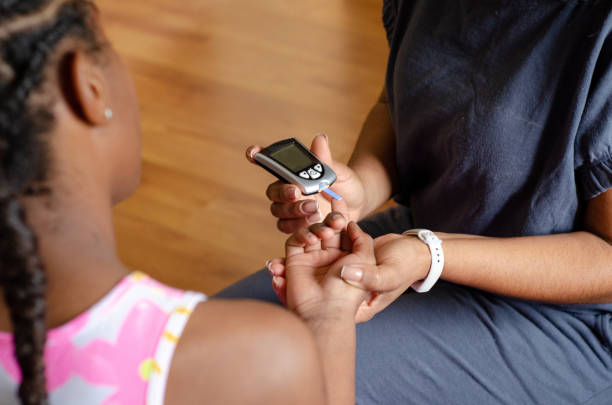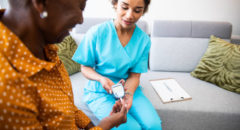
Although the number of children with type 2 diabetes is growing, type 1 is still the most prevalent form of the disease in people younger than 18. Type 1 diabetes is an autoimmune disease, which means the body's own immune system, designed to attack infectious agents invading from outside, instead attacks cells that perform a healthy, normal body function.
RELATED: Obesity Could Raise a Child's Odds for Type 1 Diabetes
In type 1 diabetes, either essential cells of the pancreas are destroyed by the immune system or the pancreas simply does not produce enough insulin, a hormone essential to life. After the food that we eat releases sugar into the bloodstream, insulin is like a key that unlocks the cells to receive the sugar for energy. Without insulin, the sugar (glucose) cannot be used, and it builds up in the bloodstream. When no insulin is available, your body starves -- even though you may have plenty of sugar in your bloodstream.
Type 1 diabetes was formerly called juvenile diabetes or insulin-dependent diabetes. For the rest of their lives, children with type 1 diabetes must get insulin shots or use a pump that delivers insulin automatically.
What causes type 1 diabetes?
The exact cause of type 1 diabetes is unknown. Children who have it may have inherited a genetic condition (why the disease develops at a particular time, whether it be in infancy, childhood, puberty, or adulthood, however, is still a mystery). It generally appears when they are very young or in their teenage years. It seems to run in the family, so if both parents are diabetic, there's a higher risk their children will also develop the disease.
RELATED: Doctors Often Miss These Signs of Type 1 Diabetes in Kids
When can you get diabetes?
Type 1 diabetes usually appears before age 30, but it can show up at any age, including infancy, and it may occur abruptly. Although it used to be unheard of in youth, type 2 diabetes is now an epidemic among children and teens. The difference between the two forms of the disease is that type 2 insulin has become ineffective while with type 1, the child's body does not produce insulin.
What are the symptoms?
Perhaps the most important symptoms of type 1 diabetes in children are frequent use of the bathroom and constant thirst. If your child has these symptoms, take them to a physician for a checkup.
These are some of the common symptoms of type 1 diabetes:
- Problems with urination, including increased frequency and bed-wetting
- Constant thirst
- Agitation or excessive irritability
- Increased appetite
- Unexplained weight loss
- Frequent infections
- Fatigue
- Sores that are slow to heal
- Dry, itchy skin
RELATED: 5 Effective Ways to Talk to Your Loved One About Managing Their Diabetes
How is type 1 diabetes diagnosed?
According to Mayo Clinic, the following tests are used to diagnose type 1 diabetes:
Random blood sugar test. The primary screening test for type 1 diabetes, this test involves taking a blood sample at a random time. Unlike a fasting blood sugar test, this test does not take into account when the child last ate. A random blood sugar level of 200 milligrams per deciliter (mg/dL), or 11.1 millimoles per liter (mmol/L), or higher suggests diabetes.
Glycated hemoglobin (A1C) test. This measures the child's average blood sugar level for the past two to three months. An A1C test measures how much sugar (glucose) is bound to the hemoglobin in red blood cells. An A1C level of 6.5 percent or higher on two separate tests indicates diabetes.
Fasting blood sugar test. A blood sample is taken after your child fasts overnight. Type 1 diabetes is indicated with a fasting blood sugar level of 126 mg/dL (7.0 mmol/L) or higher.
RELATED: Type 1 Diabetes Could Be Causing Your Muscle Weakness
Is there a cure for type 1 diabetes?
Unfortunately, there's not yet a cure. Diabetes is a chronic, lifelong disease requiring both intensive self-care and medical care. Without proper care, the disease can cause both acute problems- immediately dangerous and even life-threatening- and chronic problems that can affect your child's quality of life and progress to long-term complications.
The good news is that diabetes is controllable, and current treatment methods have an excellent success record. By taking insulin, watching blood sugar levels, and getting regular exercise, children with type 1 diabetes can lead healthy and active lives.
What are the most severe long-term complications?
Without proper management, type 1 diabetes can cause eye disease and blindness. It can also damage nerves, kidneys, and the large and small blood vessels, which can lead to other health problems such as stroke and heart disease. If untreated over the long run, it can lead to arteriosclerosis, leg sores, hypertension, edema, chronic infections, and even death.
RELATED: Researchers May Be Close to a Cure for Type 1 Diabetes
What is the treatment for type 1 diabetes?
Diabetes treatment is tailored to the individual child and should be planned in consultation with a doctor and other health professionals. Children with diabetes can expect to grow up normally. Because type 1 diabetes means your child's body produces little or no insulin, however, its treatment generally requires a strict regimen, including a well-planned diet, physical activity, blood sugar testing several times a day, and insulin. (Self-monitoring for blood glucose involves pricking the finger or arm for a drop of blood that is placed on a strip and read by a small, portable meter.)
Although the treatment for type 1 diabetes always includes insulin, this hormone can be administered either by injection (usually in multiple injections throughout the day) or through a device placed under the skin with an externally worn insulin pump, which delivers exact amounts of insulin throughout the day and night.
If you have a small child, you will probably have to monitor and test him or her until your child is old enough to do it independently. At any given moment, your child's blood sugar level may be too high, which requires an insulin shot or increased physical activity, or too low, requiring glucose from food or drink, from candy or glucose tablets, or perhaps an injection of the hormone glucagon for severe lows. This means you'll need to ask your doctor or diabetes educator about the physical and behavioral cues that indicate a change in blood sugar levels among infants and young children, who can't talk about the symptoms they're experiencing.
As your child gets older, some of these necessities can be hard to adjust to. Teenagers, in particular, may become impatient with caring for their disease, so managing diabetes can be a tough balancing act. Parents need to work with their children to keep diabetes under control, and this requires both education and practice.
Working closely with both doctors and diabetes educators will help you manage the disease by creating a successful partnership with your child.
With the help of an adult, older children can learn how to manage their condition on their own. Children with diabetes do not generally need special medical attention. Most schools allow children to get their blood sugar tests and insulin shots at school.
However, a student who needs to be on a regimen of blood testing, insulin injections, and a special eating schedule to control diabetes may raise issues for some schools. It's important to meet with teachers and other school staff to discuss your child's needs. Many health organizations, such as Children with Diabetes, offer excellent resources to parents and teachers on caring for children with diabetes at school.
Further Resources
The American Diabetes Association.
The National Diabetes Information Clearinghouse (NIDC), part of the National Institutes of Health.









